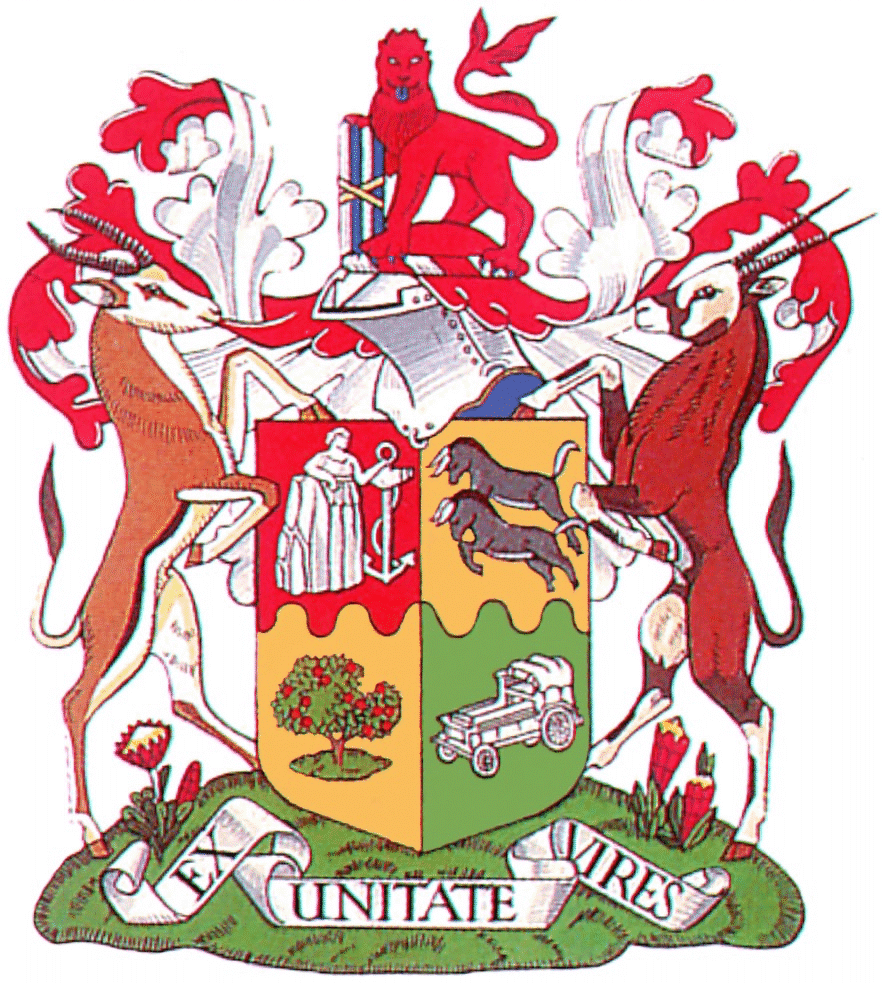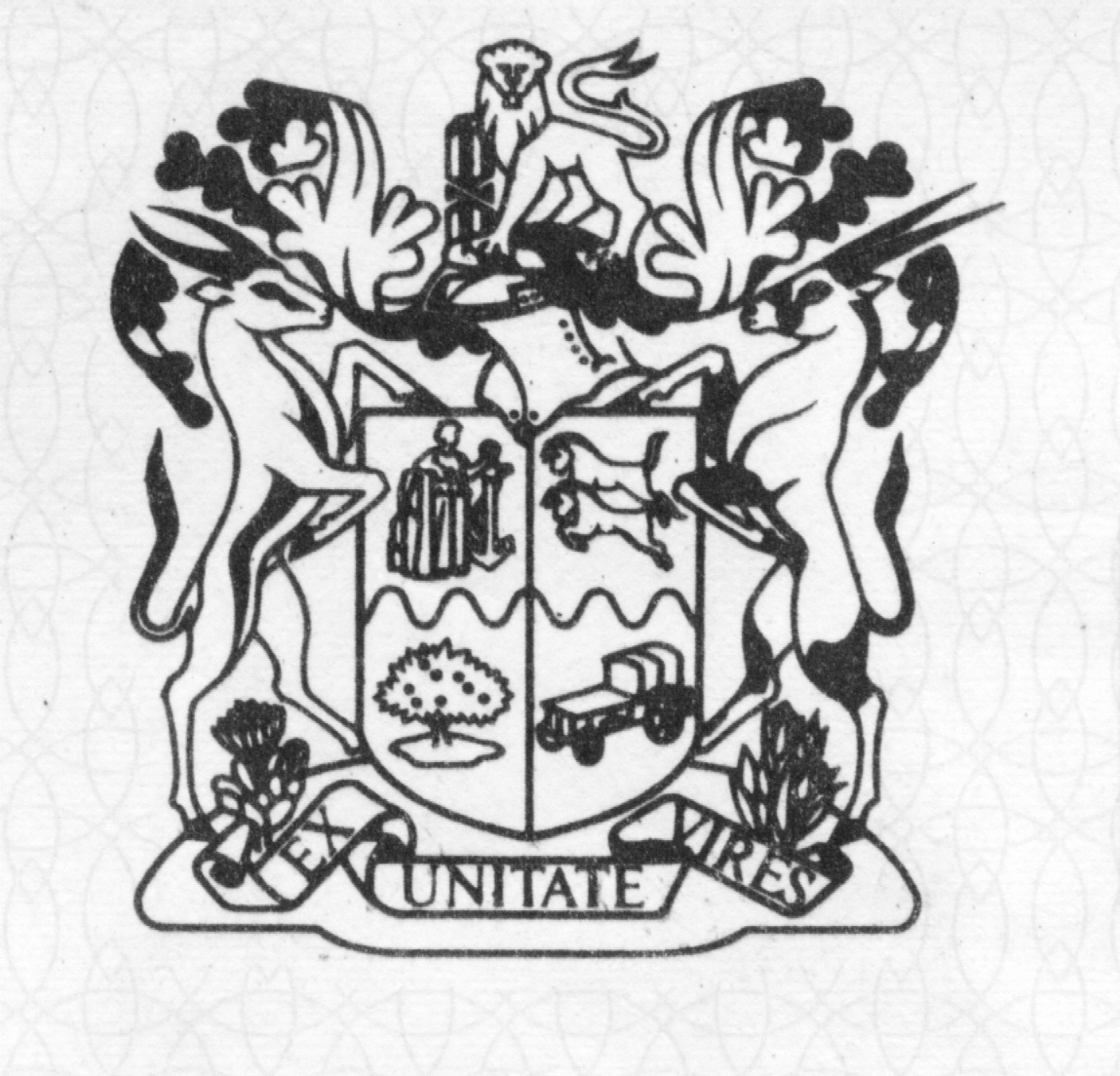

Republic of South Africa
Republiek van Suid-Afrika

Arms registered in Pretoria:
South Africa became a republic outside the Commonwealth on 31 May 1961. In 1962 Parliament passed the Heraldry Act, which created a heraldic authority comprising the Bureau of Heraldry, headed by a State Herald. The first State Herald was appointed in 1963 and had his office in the Union Buildings, Pretoria (it has since moved elsewhere in Pretoria).
The bureau registered the national arms by certificate No 152, dated 13 May 1968. The illustration follows the Kruger Gray drawing and the wording of the blazon is significantly different from that of 1910, but the arms so blazoned are still those granted in 1910 and redrawn in 1930 and ’32. The blazon reads:
Arms: Quarterly per fess wavy: I, Gules, a female figure representing Hope, resting the dexter arm upon a rock, and supporting with the sinister an anchor Argent; II, Or, two black wildebeest in full course at random, both proper; III, Or, upon an island an orange tree Vert fructed proper; IV, Vert, a trek wagon Argent.
Crest: On a wreath of the colours, a lion passant gardant Gules, supporting with the dexter paw four staves erect, alternately Argent and Azure and banded Or.
Mantling: Argent and Gules.
Supporters: Dexter a springbok and sinister an oryx (gemsbok), both proper.
Compartment: Below the shield, on a compartment grassed Vert two Proteas each with two flower heads proper.
Motto: EX UNITATE VIRES.
The wording of the blazon does not specify the colours of the crest-wreath or mantling, but in accordance with tradition, the wreath and mantling are in the same colours.
Constitution of the republic:
South Africa’s becoming a republic changed little in its Constitution. The new position of State President differed from its predecessor, Governor-General, only in that the officeholder did not represent the British sovereign. The position was still largely ceremonial, and political power was still concentrated in the Prime Minister – more so than before the 1950s, because (in terms of the Appeal Court ruling mentioned above) Parliament was now held to be sovereign. With regard to language, the Constitution now specified English and Afrikaans, rather than English and Dutch, but the equality between the two languages was unchanged, as was the entrenched nature of the language clause.
1984 Constitution:
In 1983 a majority of white voters approved a new Constitution, which was adopted in 1984, that abolished the office of Prime Minister and concentrated power in the hands of an executive State President. The sitting Prime Minister, P W Botha, was elected State President. This Constitution also abolished the Senate and the four Provincial Councils, as well as representation in Parliament for South West Africa.
It purported to give Coloured and Indian South Africans a say in the country’s affairs by creating two new Houses of Parliament, the House of Representatives (for Coloureds) and the House of Delegates (for Indians). However, since the seats allocated to these two Houses were permanently limited to 50% of the House of Assembly for the Representatives and 25% of the Assembly for the Delegates, this was clearly a farcical concession. The majority of those eligible to vote for these two Houses declined to even register, and those elected were regarded as not authentically representing the people.
Black South Africans were not brought into this reckoning, because in terms of apartheid policy they exercised their democracy through the the “independent” homeland states of Transkei, Bophuthatswana, Ciskei and Venda, as well as the six non-independent homeland states.

New drawing of arms:
Brownell writes: “At the request of the Office of the State President slightly simplified versions of the 1932 embellished arms were prepared by the Bureau of Heraldry in 1986, specifically for single colour printing and for gold blocking.” This version was used until the arms of 1910 were finally replaced by the new device adopted in 2000.
No new full-colour drawing of the country’s coat of arms was prepared after 1961, and the 1932 drawing continued in use until 2000.
Further changes:
Since the 1960s South Africa had experienced a low-intensity war with liberation movements in both the Republic and South West Africa (officially designated Namibia by the United Nations). During the 1970s, South African troops were sent to the north of South West Africa to contain Swapo insurgencies, and on several occasions South African forces entered Angola in support of allies in that country’s civil war. The South African Police also assisted Rhodesia’s British South Africa Police in the war there, and attempts were made to undermine Frelimo, the liberation movement in Mozambique which had assumed power upon the withdrawal of the Portuguese. The campaign within South Africa was characterised by acts of sabotage, bombings and, at a later stage, killings, while the security forces became notorious for violations of human rights.
The fall of the Soviet Union in 1990 meant that giving in to UN demands to grant Namibia independence would no longer open the border with that country to infiltration by Moscow-backed insurgents. Namibia received its independence, but within South Africa President P W Botha continued policies which were increasingly seen as harmful to the country.
Botha suffered a stroke late in 1990 which to a large extent incapacitated him, but he refused to resign. His National Party outmanoeuvred him by replacing him as party leader, which precipitated his resignation and replacement by F W de Klerk. De Klerk took action by announcing at the opening of Parliament in February 1991 that numerous restrictions introduced during the previous 30 years would be dropped, notably that the resistance movements would be unbanned and their leaders (particularly Nelson Mandela of the African National Congress) would be released from prison. Talks would be held to map out a new future for the country.
The talks eventually got under way at Kempton Park under the name of the Congress for a Democratic South Africa (Codesa), at which all South Africa’s political movements were represented. An interim Constitution was drawn up, and it was agreed that all-party elections – in which all citizens would have the vote on a non-racial basis – would be held over a number of days starting on 27 April 1994. Right-wing objections were largely neutralised by a 1993 referendum which authorised De Klerk to continue reforming. The parties also agreed that, initially, a Government of National Unity would be set up, rather than a winner-takes-all situation.
The outcome was internationally acclaimed as a miracle when four days of polling went off with barely a hitch and civil unrest virtually disappeared. Nelson Mandela was elected President (the title State President fell away) and took control of a National Defence Force in which members of the former Defence Force served on an equal basis with members of the liberation movements’ armed forces.
A new flag was taken into use on 27 April 1994, but it was agreed that the coat of arms would remain in use provisionally. It was clear that a new device was needed, since the old one represented the four colonies that had joined in 1910 and become provinces of the Union; these had been replaced on 27 April by nine provinces, of which only one had the same area as in 1910, one was slightly larger, and one had been created by joining pieces of two different former provinces.
On 27 April 2000, a new coat of arms was unveiled by President Thabo Mbeki.

Vir Afrikaans, kliek hier
Comments, queries: Mike Oettle